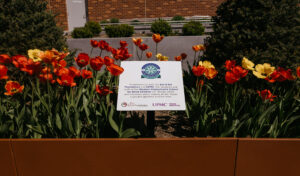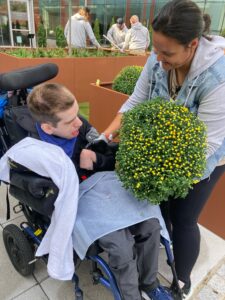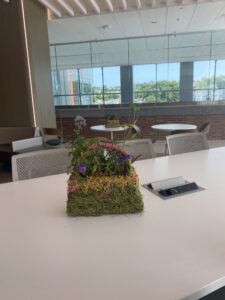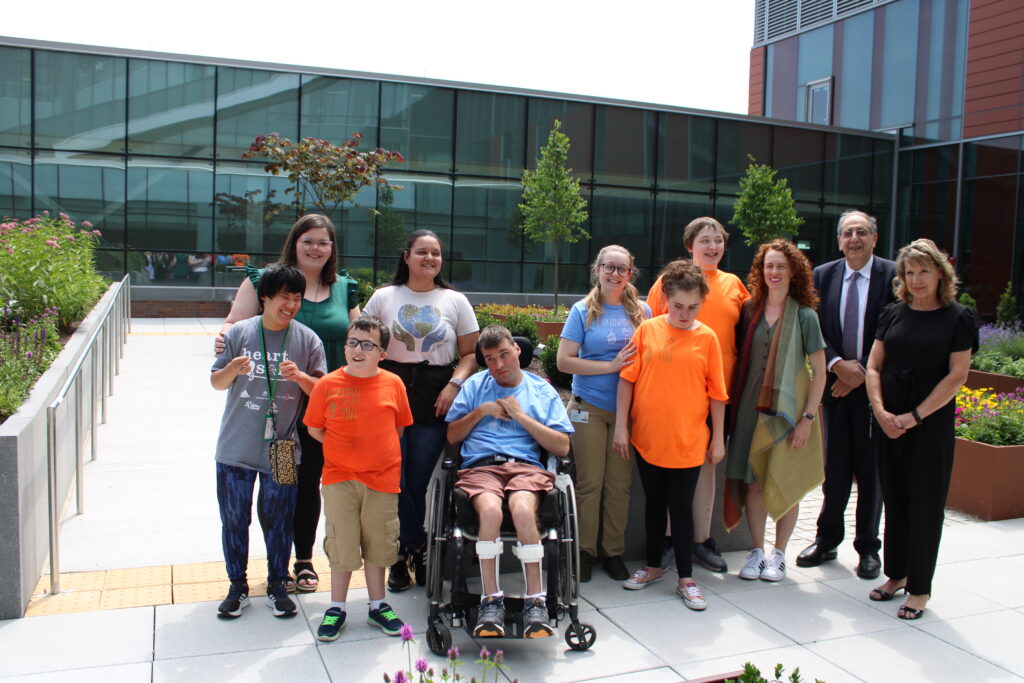The most common diagnosis in children who attend the Western Pennsylvania School for Blind Children (WPSBC) is cortical visual impairment (CVI). Preeti Patil, MD, a pediatric ophthalmologist and neuro-ophthalmologist who runs a nystagmus clinic at Children’s Hospital of Pittsburgh, opened the Eye & Ear Foundation’s July 29th webinar, “Childhood Vision & UPMC/WPSBC Garden Collaboration,” by talking about this condition. Following her presentation, the webinar shifted to the exciting garden collaboration between UPMC and WPSBC.
What is CVI?
Also referred to as cerebral vision impairment or brain-based vision impairment (BBVI), CVI is when the eyes can see but the brain cannot interpret the visual world. It is characterized by bilateral visual acuity or visual field loss in the presence of a normal eye examination or vision loss that is greater than expected based on the degree of ocular pathology. CVI occurs from damage to the postgeniculate visual pathways, or the pathways to the brain.
In the U.S. and other developed countries, CVI is the leading diagnosis of visual impairment for children ages zero to three. Children with CVI can have a large spectrum of visual disorders, including poor vision, complex visual processing deficits, visual field deficits, face and spatial recognition defects, and color and contrast recognition defects
Some children with CVI may have good visual acuity but may suffer from other complex visual issues and are often difficult to diagnose.
Causes of CVI
The most common cause of CVI is perinatal or postnatal hypoxia (lack of oxygen) in preterm or term children. Other causes include:
- Hydrocephalus
- Trauma including nonaccidental trauma
- Infections: meningitis, encephalitis
- Metabolic and/or genetic disorders
- In utero drug exposure
- Structural brain abnormalities
- Seizures
Features of CVI
How does a child with CVI present? Dr. Patil gave two examples. One is of a young mother who brings her six-month-old baby to the clinic and says, “My baby doesn’t look at me. He won’t smile at me, but my other eye doctor told me his eyes are fine! Why does this happen?” The other example was of parents who bring in their five-year-old son who just started kindergarten. He is scared in a crowded classroom, having trouble reading, and finds it difficult to play with all his friends when they play together with multiple toys. The optometrist says his eyes are ok. “What can we do to help our son?” the parents ask.
Depending on the extent of CVI and seizures, features vary. They include:
- Poor vision – lack of eye contact, inability to recognize faces, unable to see objects clearly, light gazing
- Challenges with complex visual input, such as viewing an object on a patterned rather than solid background
- Often prefer to view objects at close range
- Visual field deficits
- Photophobia
- Ocular motor deficits
Diagnosing CVI
CVI manifests in many ways. Any of the cerebral visual functions may be affected, in any combination and to any degree. In children with marked CVI or other neurological problems, the diagnosis may be obvious. In children who are otherwise apparently normal, the symptoms and signs may be more subtle, and the diagnosis must be considered and explored.
A diagnosis comprises of:
- Detailed history taking
- Several caregiver questionnaires that assess various aspects of visual functioning – Visual Skills Inventory developed by Dr. Dutton, a 12-question short CVI questionnaire
- CVI Range – Dr. Roman
- Specific questions directed at visual behavior differences
- Ophthalmic exam
- Visual field assessment
- Electrophysiology
- Neuroimaging
An ophthalmic assessment consists of:
- Complete eye exam – examine the structure of the eye
- Ocular motility exam – nystagmus (eyes which shake), strabismus (eye misalignment)
- Accommodation and convergence – ability to focus at different distances
- Cycloplegic Refraction for glasses – to detect any associated far/near sightedness or astigmatism
CVI Management
Under the care of an ophthalmologist, there are ways to manage CVI:
- Correct refractive errors: Glasses, bifocals
- Strabismus evaluation: Look for amblyopia (lazy eye)
- Amblyopia management: Eye patching, drops
- Strabismus management: Botox injections, surgery
- Nystagmus management: Correction of any associated head postures if needed by eye muscle surgery
- Diagnosing associated ophthalmic abnormalities: Optic atrophy, optic nerve hypoplasia (structural abnormalities which may be present)
“And of course – most importantly – [management includes] appropriate referrals for CVI functional vision assessment, [and] early intervention,” Dr. Patil said.
A team approach is used, with an ophthalmologist, teacher for the visually impaired (TVI), pediatricians, and rehabilitation specialists (including OT/PT) all working toward the same goal.
Strategies and Interventions
Strategies to help visual functioning:
- Individualized interventions must be created based on the student’s use of vision, strengths, needs, interests, and routines at home/school
- Use of black backgrounds to eliminate visually complex environments
- Materials chosen based on the child’s preferred color and presented in their best visual field
- Use light to direct vision
- Materials and targets can be presented on a light box or backlit device
Interventions at School
- Print work (such as worksheets) can be adapted to include less on a page or by covering some of the visual information by using a typoscope or line marker
- Using visually clean fonts
- Well-spaced between words and lines of print
- Learning materials presented on a backlit device such as a tablet or computer screen
- Material presented upright on a reading stand
- Long passages made accessible through the use of screen readers
UPMC Vision Institute at UPMC Mercy Pavilion and WPSBC Horticulture Collaboration

The next part of the webinar focused on the collaboration between UPMC and WPSBC. The partnership involves Ed Dudek and Kelly Noel from UPMC Corporate Services, Roberta Kiefer from BMS Grounds, and Marian Gagu from Mercy Engineering and Maintenance.
Through happenstance, Roberta Kiefer, manager of UPMC BMS Grounds – whose teams cover the Presby/Oakland, Shadyside, and Mercy campuses as well as many corporate properties – got an email from Carrie Fogel, EEF Senior Director of Development, Corporate and Foundation Relations asking if her team worked on sensory gardens. In fact, Kiefer has a background in landscape design and installation. She has participated in many community partnerships and facilitated the design and install of therapy gardens throughout her coverage area.
Kiefer was happy to add the garden at UPMC Mercy Pavilion to her list. She met with Carrie, Lawney (EEF CEO), and Dr. Rachelle Rectenwald, Assistant Superintendent at WPSBC and was immediately taken by how incredible the school is and its horticulture program. She approached her leadership about the potential partnership, and the entire team was on board right away, “because it’s such a fascinating and great program that we want to be a part of it.”

Gardens were taken over for those students to plant, design and work in. They come to the facilities on average once a week and work with Kiefer’s team in weeding, planting, harvesting, and interacting with the other employees and patients on that floor. “It’s been a real honor for me and my team to be involved in something like this,” Kiefer said.
Dr. Rectenwald said she appreciates the partnership and the way UPMC has supported the school not just financially but with their time, which is so valuable and has contributed to its success. It has been a little over a year since the project started. The school has a student population and serves adults. “It has been a joy to watch how our students are thriving, in another environment, off site, away from school and adult programming,” Dr. Rectenwald said. “They’ve certainly gained a lot.”
WPSBC
Dr. Rectenwald then played a video about the school, with an open invitation issued to come and see how special the school is.
Approximately 70% of WPSBC students are diagnosed with CVI, which is 140 students. Ten students have optic nerve hypoplasia. Seven have retinopathy of prematurity. Eleven have retinal issues like detached retinas or retinal dysplasia. About 12% of the student population is dually diagnosed with deaf-blindness.
Gardens
The gardens have a sensory approach and were created with intention. Deb Frank from the adult program at WPSBC has a specialty in therapeutic landscape design, which was valuable. The gardens have great visual contrast. Saturated colors and movement are good for children with CVI. Raised flower beds provide accessibility for all individuals.
The Rehabilitation Garden utilizes all the senses. Bright colors (sight), wind chimes (sound), mint/herbs (taste/smell), and textures/Braille (touch) ensure that everyone can enjoy what it has to offer.
Kiefer’s team, WPSBC students, and staff help maintain the gardens.
“I invite anyone who’s in the area and can stop on the fourth floor of the Vision Institute to check out what’s been done up there,” Kiefer said. “It’s absolutely incredible.”
Dr. Rectenwald pointed out that in addition to all the textures, signs are available for people to enjoy too – in print and Braille. The garden has year-round care and employs seasonal decoration. People can pick and eat the vegetables if they wish. “Our staff appreciate being engaged in a different way, and I see the joy on the students’ faces, which means everything to us,” Dr. Rectenwald said.

Centerpieces are even created for the grab-and-go cafeteria using materials from the garden.
WPSBC offsite uses technology to print 3D guides for plugs, which do not take long to create. This allows vision impaired people to know where to direct the plug. It is visually attractive as well. People are welcome to use as they see fit.
Future Plans
The goal is to expand opportunities for adults, including employment. Future plans also include the continuation of students and adults from WPSBC volunteering, contributing, and participating in the community, and maintaining the garden.
Kiefer hopes to continue these programs well into the future with the support of leadership, which so far has been 100%. Dr. Rectenwald said the board is committed to providing a lifetime of learning.
“This is why the partnership has been so beneficial to many,” Dr. Rectenwald said. “We have a similar philosophy to UPMC in that we want others to see our students and adults and realize the potential they have and to see hope and opportunity in them.”
People do not always receive good news when leaving a medical facility, but if on their way out, they happen to see one of the engaged, smiling students, they might leave with a sense of hope knowing this is what they have to look forward to, Rectenwald said. People can take some of the ideas used in the garden and put them to use at home. There are fun, exciting ways to be engaged and learn without being aware that it is work, and it is also a family-friendly activity.
Fogel acknowledged Dr. Sahel’s part in the project. When they came up with the idea, they consulted with him, and he felt very strongly that we create a space for the students to have at the Vision Institute. “It was very much influenced by his research and his work and his overall commitment to meeting the needs and potential of all the people that we’re here to serve,” Fogel said.
